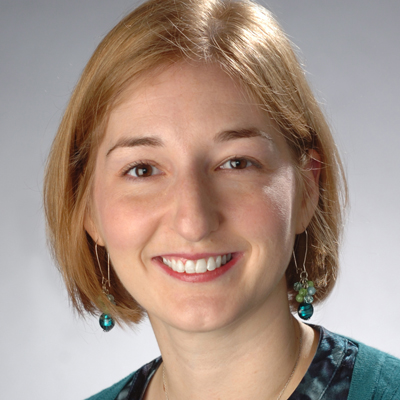Making predictions in health and material science using analytical physics tools
While cell biology has typically focused on activities that happen inside single cells, many important biological processes involve cells interacting strongly with one another to generate large-scale patterns. Even the simplest interactions between large numbers of cells can yield surprisingly complex behaviors, and therefore predictions based on simple models can be very powerful in understanding processes like wound healing, cancer metastasis, or congenital disease. Dr. M. Lisa Manning, Associate Professor of Physics at Syracuse University, uses a set of tools from statistical and soft matter physics that are uniquely suited to these strongly interacting groups of cells, and works closely with other interdisciplinary scientists in biology, bioengineering, and medicine to make predictions about complex systems with practical applications. Using both computer simulations and theoretical physics tools, Dr. Manning develops predictive models for cell interactions, working closely with biologists and medical professionals to test those hypotheses and generate new ideas about how to treat diseases.
For example, recent theoretical predictions developed by the Manning group have been remarkably accurate in predicting cell shapes and cell motion in specific tissues, including those from human asthma patients and breast cancer cell panels. Interestingly, some of these same tools and techniques can be applied to a very different set of problems in materials science. For example, by identifying and analyzing the dynamics of “soft spots” or flow defects in certain granular materials that play an important role in earthquakes, Dr. Manning is able to more accurately predict friction and failure in these solids. These flow defects also play an important role in promising new types of structural materials, such as bulk metallic glasses.
Because Dr. Manning uses techniques that are very different from those typically employed by cell biologists or material scientists, the insights and predictions she develops and verifies are often surprising and even counter-intuitive to experts in those fields. Therefore, these predictions have the potential to provide paradigm-shifting breakthroughs in areas as diverse as creating predictive models for asthma progression and treatment, developing novel diagnostic tools for quantifying cancer tumor invasiveness, improving hazard analysis on earthquake faults, processing granular matter in industry, and designing new structural materials such as bulk metallic glasses.
Current projects include:
- Metastasis in Cancer Tumors: In collaboration with scientists in Leipzig, Germany, Dr. Manning and her team are quantifying the mechanical properties of primary cells of human patients with breast and cervical cancer. They have developed specialized mathematical models to predict the behavior of the tumor, including how likely the tumors are to metastasize, which they anticipate will form the basis of improved diagnostic tools for quantifying cancer invasiveness.
- Jamming Transition in Asthma: Dr. Manning and her team are working on a groundbreaking piece of work to predict when the epithelium tissue that lines the lungs behaves in a solid-like, or “jammed” manner, or in a fluid-like, or “unjammed” manner. They have recently discovered that in asthma patients, this jamming transition is significantly delayed compared to normal patients, which is an entirely new way of diagnosing asthma. Currently, the team is testing the implications of different treatments such as steroids on this transition.
- Congenital Diseases: Dr. Manning is collaborating closely with Dr. Jeffrey Amack at Upstate Medical University to study the organ of asymmetry in zebrafish embryos, which dictates the left-right symmetry in all vertebrates. By studying what mechanical forces give rise to left-right symmetry breaking, Dr. Manning hopes to identify mechanisms leading to malformations in left-right pattering and congenital diseases and identify promising biochemical targets for treatment of such diseases.
- Catastrophic Failures of Bulk Metallic Glasses and Granular Materials: The organization of defects is what leads to catastrophic failures in the disordered material inside earthquake faults, and Dr. Manning and her team are working to develop new tools to track these defects. As the first in the world to discover a way to identify these defects, Dr. Manning is uniquely positioned to study how defects organize and interact with one another inside earthquake faults. In addition, Dr. Manning studies how the same kind of catastrophic failure events happen in bulk metallic glasses, which are new structural materials that, while promising, cannot yet be used for building large-scale structures because they fail too easily. Ultimately, Dr. Manning hopes to improve hazard analysis on earthquake faults and develop these new structural materials.
Bio
Innately curious and encouraged by her parents, Dr. M. Lisa Manning possessed a strong interest in science throughout her childhood, building “computers” with legos and electrical circuits with LEDs. However, growing up in Kentucky, there were not many role models for women in science or physics. Luckily, she was encouraged by a high school science teacher (Sister Mary Ethel Parrott) to participate in the science fair club. She won first place in the engineering category of the Intel International Science and Engineering Fair for a project that involved building a microbial fuel cell in her basement. She used the award money to buy her first car, and the experience cemented her idea that science was her “ticket” to new experiences and knowledge outside her hometown, and where she could contribute to society in a positive way.
Dr. Manning also had a fantastic mentor as an undergraduate student at the University of Virginia, who hired her as a research assistant her freshman year, which was a big risk. Here, she worked on high energy experiments and particle collider physics. While she enjoyed doing collider physics, she also wanted to work on something where she could make an immediate difference in people’s lives. As a graduate student and postdoctoral researcher, therefore, Dr. Manning gravitated towards soft matter and biophysics -- a beautiful match between mathematical theory and physics, which she found extremely fun to teach and learn, and allowed her to make predictions with immediate, real world practical applications.
Now, Dr. Manning has a strong passion for her own students. Hosting a conference for undergraduate women in physics at Syracuse University, she is very interested in women in science, and is actively involved in trying to increase the participation of women and underrepresented minority in physics.
Aside from her research, Dr. Manning likes to snowboard. In fact, she took a year off between her undergraduate and graduate years to be a “ski bum.”
For more information, visit https://mmanning.expressions.syr.edu/
In the News
Syracuse University
Syracuse University
Harvard School of Public Health
National Science Foundation
Syracuse University
Research Corporation for Science Advancement


